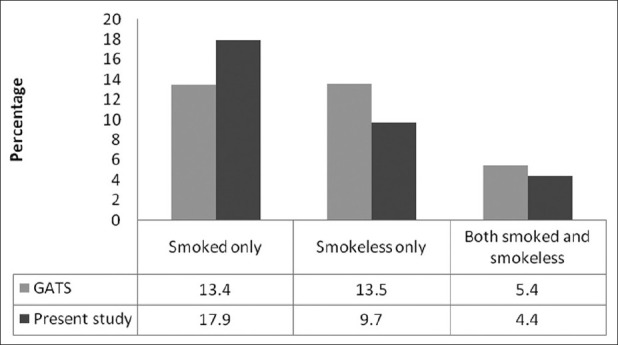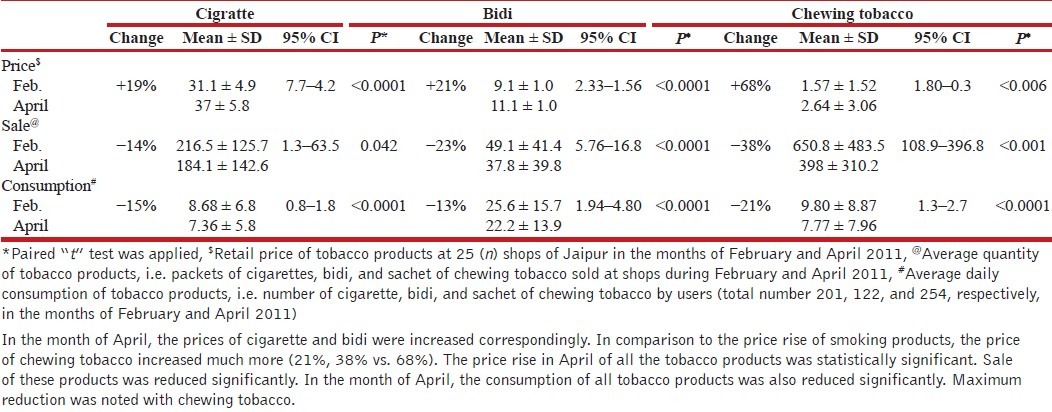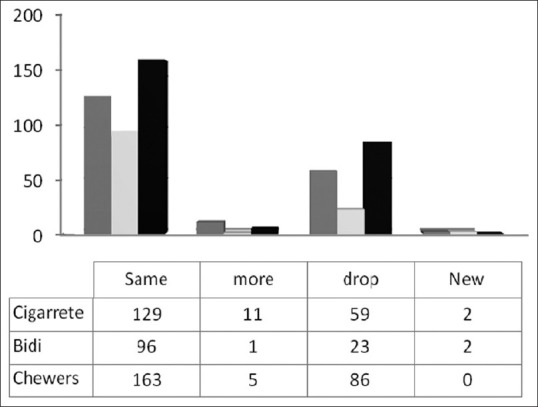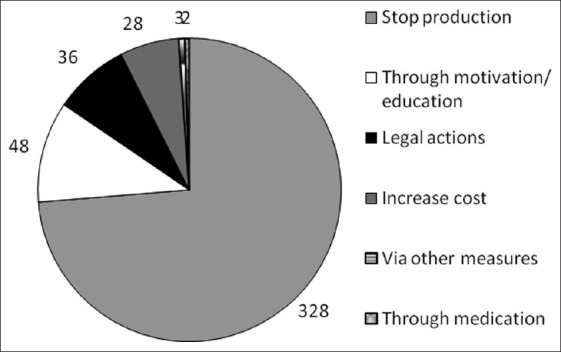Abstract
Background:
It is thought that price increase in tobacco products leads to reduced consumption. Though many studies have substantiated this concept, it has not been well studied in India. Recently, price of tobacco products was increased due to ban on plastic sachets of chewing tobacco and increased tax in Rajasthan. This study was designed to evaluate the effect of price rise on overall consumption of tobacco in Jaipur city, Rajasthan.
Materials and Methods:
This study was carried out in Jaipur city. Two-staged stratified sampling was used. In the first phase of study, cost and consumption of various tobacco products in the months of February and April were enquired from 25 retail tobacco shops. In the second phase, tobacco consumption was enquired from 20 consecutive consumers purchasing any tobacco product from all the above retail tobacco shops. The data were statistically analyzed using descriptive statistics and paired “t” test.
Results:
The comparison of prices of tobacco products between February and April revealed that the price of cigarette, bidi, and chewing tobacco has increased by 19%, 21%, and 68%, respectively. Average decrease in sales of cigarettes, bidi, and chewing tobacco at shops included in the study were 14%, 23%, and 38%, respectively. The consumers purchasing tobacco also reported decreased consumption. Chewing tobacco showed the maximum reduction (21%). Consumption of cigarette and bidi has also reduced by 15% and 13%, respectively.
Conclusion:
It may be concluded that reduction in consumption is associated with increased price of tobacco products. Reduced consumption is comparative to the magnitude of price increase.
KEY WORDS: Consumption, legislation, plastic sachet, price, tobacco sale, tobacco taxes
INTRODUCTION
Tobacco use is the biggest preventable cause of mortality, and the most common cause of tobacco-related deaths is respiratory diseases such as chronic obstructive pulmonary diseases (COPD).[1] The report of Global Adult Tobacco Survey (GATS) showed that 35% of adult population in India use tobacco in any form.[2] Therefore, steps are needed to reduce the tobacco use. Increasing the cost of tobacco products has been proposed as an effective step to decrease the consumption. Various studies have demonstrated reduced tobacco consumption with increasing price.[3,4]
World Bank suggested that a 10% hike in tobacco price leads to reduction in consumption of tobacco by 4% in developed and by 8% in developing countries.[5] John analyzed the Indian data of 55th round national sample survey carried out during 1999–2000 and calculated the price elasticity of tobacco products.[4] John predicted that 10% increase in cost of bidi would reduce the consumption by 9.2% and similar increase in cigarette cost will reduce its consumption by 3.4%.[4] Data using International Tobacco Control Survey of Bangladesh also showed that 10% price increase causes 4.6% reduction in bidi and 2.9% reduction in cigarette consumption.[6]
Since direct evidence of price increase resulting in reduced consumption is a difficult situation to create, such indirect studies provide good evidence. Fortunately, a proper situation was created after the budget session of Rajasthan government. In view of the menace of tobacco, the Government of Rajasthan increased the tax on all tobacco products from 20 to 40% from 1 April 2011. It was the highest tax on tobacco products in the country.[7,8] The cost of chewing tobacco was affected even further. In a writ petition of Indian Asthma Care Society (IACS), Asthma Bhawan, Jaipur, the Supreme Court of India imposed a ban on plastic sachets of chewing tobacco from 1 March 2011.[9] With the ban, the price of chewing tobacco got increased even more than bidi and cigarette. These two actions led to differential increase in cost of chewing and smoking tobacco products. It provided the ideal situation to study the direct region-specific effect of price rise on tobacco consumption. Therefore, we undertook this study to evaluate the effect of price rise on the consumption of various tobacco products.
MATERIALS AND METHODS
This study was conducted in Jaipur city which is the capital of Rajasthan state. It was conducted in two phases to recruit shops as well as consumers. Two-staged stratified sampling technique was used to select the study subjects. Since no such prior study has been undertaken so far, for borrowing the estimates of levels of decrease in consumption of tobacco use due to price rise in India, it was safe to assume that 50% of the users would have reduced consumption.[10] Therefore, sample size was based on assumption of a 50% reduction in consumption due to price increase and 95% confidence interval with relative standard error of 5%. Finally, for a two-staged sampling, a design effect of 1.3 was included to arrive at the sample size of 499. A listing exercise was done to identify as many retail sales counters as possible for sampling frame. For convenience, Jaipur city was divided into five geographic zones (north, south, east, west, and central zone). In each zone, five shops were selected randomly so that in the first phase 25 retail shops were included. The selected 25 shopkeepers were interviewed after getting their informed consent. Based on sales register data, total monthly sales of three types of tobacco products and average daily sales were calculated. Shopkeepers who did not maintain a register or were not willing to divulge the information were not included in the study. Retail price of all tobacco brands in these reference months was noted. In Rajasthan, about 90% smokers and tobacco chewers purchase tobacco products from stores.[2] Bidi, cigarette, and chewing tobacco were the three categories of tobacco products included in the study.
Two questionnaires were prepared. One was administered to shopkeepers, while the other was for tobacco users. Both these questionnaires were developed and pre-tested on similar study subjects, keeping the study objective in mind. Questionnaire for shopkeepers mainly focused on questions like cost of common tobacco products and quantity of tobacco items sold in a day during February and April 2011.
With plastic ban, the packaging material of polymer film packaging was changed to alternative paper packaging which was probably more expensive.[11] Since plastic ban was imposed from 1 March and tax was increased from 1 April, the average daily sales of February and April were taken as reference months representing the price of tobacco products before and after the increase in cost of the tobacco products. In the second phase of the study, tobacco-user questionnaire was administered to 20 consecutive persons purchasing tobacco products at every shop. This questionnaire enquired about the use of tobacco items in February and April. The subjects who were purchasing tobacco products for other persons were not included in the study. Subjects younger than 18 years of age were also not included. The questionnaire also enquired about data such as age, sex, and occupation. Specific questions enquired about the type and average daily quantity of tobacco they were using during the months of February and April 2011. If variation in consumption was observed during February and April, then the possible reason of variation was asked. Quantity of use at the individual level was assessed by mentioning the number of cigarettes, bidis, or chewing tobacco sachets consumed daily. The questionnaire also enquired about the opinion on measures required to be taken to stop tobacco use.
The study was approved by the ethics committee. The results like rise in price, change in the consumption, and opinion of study participants about tobacco use were analyzed using descriptive statistics. We had two sets of data for each category, i.e. bidi, cigarette, and chewing tobacco. Therefore, the significance of difference between average consumption of a tobacco product reported by shopkeepers and at an individual level before and after increase in price was analyzed using paired “t” test.
RESULTS
The response rate of the shopkeepers was 100%, while the response rate of consumers was 95%. There was an overlap in response to individual products from the consumers as about 49 responders were consuming more than one product, i.e. either cigarette with chewing tobacco or bidi with chewing tobacco. Overall, the pattern of tobacco use was similar to that of GATS[2] on Rajasthan [Figure 1].
Figure 1.

Pattern of tobacco use as compared to GATS (2009–2010). The numbers in the table represent percentage. The pattern of tobacco use in the present study was almost the same as that of GATS data for the state of Rajasthan except a slightly higher score seen in “smoked only” fraction. Please note that in our study, we collected data about tobacco users only. Therefore, percentage of non-users (not shown in the figure) was kept at the same level as that of GATS data for comparison
The tax on tobacco products was increased by 20%. In the shopkeeper survey, the average rise in retail price of cigarette, bidi, and chewing tobacco was 19.0%, 21.3%, and 68%, respectively. Paired “t” test showed statistically significant rise in price with a P-value of < 0.0001 for cigarette and bidi and < 0.006 for the chewing tobacco [Table 1].
Table 1.
Percentage of change in the price, sale, and consumption with their statistical significance among commonly used tobacco products

At the shopkeeper level, the sale reduction was associated with price increase of the tobacco products during April in comparison to February. Average percentage decrease in sales of cigarette, bidi, and chewing tobacco was 14.0%, 23.0%, and 38.8%, respectively, with P-values of <0.042, <0.0001, and <0.001, respectively [Table 1].
Survey of tobacco users also showed reduction in consumption of various tobacco products. Consumption of cigarette, bidi, and chewing tobacco showed a reduction of 15.2%, 13.2%, and 20.7%, respectively, with a P-value of <0.0001 in each category [Table 1]. With every 10% increase in the price of tobacco products, the magnitude of reduction in sales at shops and consumption by users is shown in Table 2. The average reduction in sales and consumption of each tobacco product, as assessed by paired “t” test, was found to be statistically significant. Graphical presentation showed a linear relationship in increase in price and decrease in sales [Figure 2]. Similarly, a relation was also seen at user level in price increase and decrease in consumption. The “drop” in consumption was maximum for the chewing tobacco group (chewers, total number = 254), while new tobacco users appeared in both cigarette (total number = 201) and bidi (total number = 122) groups. Sixty-four percent of cigarette and chewing tobacco users and 78% of bidi users continued to consume the “same” amount of respective tobacco products. Only a few users in the all the groups were consuming “more” than the previous quantity after price rise. The number of such users in the cigarette group (5%) exceeded the other two [Figure 3]. Prohibiting tobacco production was suggested as the most effective measure to stop tobacco use [Figure 4].
Table 2.
Decrease in sales and consumption of tobacco with every 10% increase in price

Figure 2.

Percentage increase in price and corresponding decrease in consumption of cigarette, bidi, and chewing tobacco at consumer level. The figure shows the effect of price rise on the sale and consumption of cigarette, bidi, and chewing tobacco. Price rise leads to decline in the sales and consumption. It should be noted that sale reduction is much higher than consumption reduction for bidi and chewing tobacco
Figure 3.

Trends in tobacco use by the study participants in April. The numbers shown in the table represent the number of consumers. The figure shows how the consumption of different tobacco products was affected by the rise in the price
Figure 4.

Opinion of study participants on how to stop the tobacco use. Most of the participants were in favor of stopping the production of tobacco. Measures required to be taken on individual level were given less significance
DISCUSSION
The Government of Rajasthan increased the tax on tobacco products from 20 to 40%.[7] It should have increased the price of tobacco products approximately by 16.7% (20 rupees increase on 120). The actual increase in price of bidi and cigarettes in our study was 21% and 19%, respectively. Probably, profit share of shopkeepers might have increased proportionally. Normally, whenever tax is increased, the retail price also increases proportionately. In our study also, in response to 20% tax hike, there was a proportional increase in the retail price of cigarette and bidi. Pattern of tobacco use in the present study was comparable to GATS data for Rajasthan [Figure 1]. According to the GATS data, a bidi smoker in Rajasthan spends rupees 148 per month on an average on bidi purchase, which is the highest in the country.[2] Therefore, increased tax on bidi is highly relevant for Rajasthan.
Price rise in chewing tobacco products was more complex. Being instrumental in promulgation of Cigarettes and Other Tobacco Products (Prohibition of Advertisements and Regulation of Trade and Commerce, Production, Supply and Distribution) Act (COTPA),[12,13] IACS attempted to restrict tobacco use indirectly by procuring a ban on plastic sachets of chewing tobacco through a Supreme Court order.[9] Though even after 1 March 2011, chewing tobacco plastic sachets were available in the market, the price of these was increased due to short supply.[14,15] Chewing tobacco in alternative packaging in paper sachets was also more expensive.[11] Therefore, the price of chewing tobacco was increased more than that of bidi and cigarette. It was probably due to combined effect of ban on sachet and increase in taxes. The actual price of chewing tobacco in our study was increased by 68%. Apart from 20% increase in tax, the additional increment in the cost of chewing tobacco sachet was probably due to the effect of ban on its plastic packaging. Almost 50% increase in chewing tobacco price was predicted by manufacturers due to change in packaging material.[11] Therefore, it can be inferred that ban on plastic sachets not only made the environment clean, but also led to the increase in cost of chewing tobacco.
Many studies showed that increasing the cost of tobacco products leads to decreased consumption.[3,4,16,17] A 10% increase in price is estimated to cause a 2.5–5.0% decrease in cigarette consumption in developed countries and 5–10% reduction in developing countries.[3] Joseph used the data of Global Youth Tobacco Survey (GYTS) which was carried out in 26 states of India from 2000 to 2004.[18] He observed that increase in tobacco price reduces its consumption. Based on cross-price estimates of elasticity in national sample survey data, John also found that increased price leads to reduced tobacco consumption.[4] These studies are based on extrapolation of the available data; therefore, results of our field study will substantiate the concept further. Our study is the first study of its kind to evaluate the direct effect of price rise on tobacco consumption in India after intervention. We also observed that every 10% increase in price of cigarette, bidi, and chewing tobacco leads to 8.0%, 6.2%, and 3.3% reduced consumption of these tobacco products, respectively. Among the tobacco products, the highest price increase was observed with chewing tobacco. The highest price rise led to the highest reduction in consumption and sales of chewing tobacco [Table 2]. The price of chewing tobacco was increased much more than that of cigarette and bidi.
Cigarette is smoked by affluent group of the society, whose consumption is affected less by price rise is a usual notion. But results of our study show that in response to 10% increase in price, the reduction in consumption of cigarette and bidi was 8% and 6.2%, respectively. It shows that cigarette users are also price sensitive. Our observations are supported by data of a study carried out by Guindon et al.[19] In their study, they found that 10% price increase causes 6–9.4% reduction in consumption of bidi and a similar change in cigarette consumption. Therefore, it can be inferred that cigarette users also reduce their smoking in response to increased prices.
In response to a question, measures required to be taken to stop tobacco use, majority of participants felt that ban on production of various tobacco products is the most effective method to reduce tobacco use in the society. Proper education about the ill effects of tobacco, legal action, and increasing cost of tobacco products are the other effective measures to reduce tobacco use in the society.
Though this study used the window period of differential increase in price of chewing tobacco and smoking, it has some limitations. Tobacco sale does not require license, therefore, it is not registered in any government office. It is very difficult to gather information about all tobacco points of sale. More difficult it is to assess the long-term effects of price change on sales and consumption because it can be affected by various ambiguous factors. In our study, the amount of tobacco use mainly depended on statement of the user. It might have had a recall bias.
Footnotes
Source of Support: Nil
Conflict of Interest: None declared.
REFERENCES
- 1.WHO report on the global tobacco epidemic, 2008 MPOWER package. Available from: www.who.int/tobacco/mpower/en page 9 .
- 2.Global adult tobacco survey, GATS India 2009-10, Ministry of health and family welfare, Government of India. Available from: http://www.searo.who.int/LinkFiles/Regional_Tobacco_Surveillance_System_GATS_India.pdf .
- 3.Chaloupka FJ, Hu TW, warner KE, Jacob R, Yurekli A. The taxation of tobacco products. In: Jha P, Chaloupka FJ, editors. Tobacco control in developing countries. Oxford UK University press; 2000. pp. 237–72. [Google Scholar]
- 4.John RM. Price elasticity estimates for tobacco products in India. Health Policy Plan. 2008;23:200–9. doi: 10.1093/heapol/czn007. [DOI] [PMC free article] [PubMed] [Google Scholar]
- 5.Reddy KS, Gupta PC. Ministry of health and family welfare, Govt. of India. New Delhi: 2004. Policy intervention: Taxation in report on tobacco control in India; p. 257. [Google Scholar]
- 6.Nargis N, Ruthbah UH, Fong GT. ITC Project Working Paper Series. Waterloo: University of Waterloo; 2010. Taxation of tobacco products in Bangladesh: Findings from the 2009 ITC Bangladesh survey. [Google Scholar]
- 7.Matharu S. Five states increase tax on tobacco in 2011. Rajasthan takes the leap by doubling tax on tobacco within a year. Governance Now 24th March 2011, New Delhi. [Last accessed on 2011 Sept 18]. at: http://www.governancenow.com/news/regular-story/five-states-increase-tax-tobacco-2011 .
- 8.Jha P, Guindon E, Joseph RA, Nandi A, John RM, Rao K, et al. A rational taxation system of bidis and cigarettes to reduce smoking deaths in India. Econ Polit Wkly. 2011;42:44–51. [Google Scholar]
- 9.Bhatnagar R. Supreme court bans use of plastic pouches to sell gutkha. 2010. Dec 7th, [Last accessed on 2011 Sep 18]. Available from: http://www.dnaindia.com/india/report_supreme-court-bans-use-of plastic-pouches-to-sell-gutkha_1478106 .
- 10.Fosgate GT. Practical sample size calculations for surveillance and diagnostic investigations. J Vet Diagn Invest. 2009;21:3–14. doi: 10.1177/104063870902100102. [DOI] [PubMed] [Google Scholar]
- 11.Gutka, pan masala to come in paper-based packaging. [Last accessed on 2011 Dec 17]. Available from: http://www.dnaindia.com/money/report_gutka-pan-masala-to-come-inpaper-based- packaging_1520808-all .
- 12.Shrivastava KS. Center bans gutkha. [Last accessed on 2011 Sep 18];Down to Earth. 2011 20:19–21. Available from: http://www.downtoearth.org.in/content/centre-bansgutkha . [Google Scholar]
- 13.Choudhary K. Ban on tobacco products in multisectorial and intersectorial approach to national tobacco control. The WHO international conference on global tobacco control law: Towards FCTC. 2000:21–22. [Google Scholar]
- 14.Kumar N. Gutka sold in black after ban on sachet. [Last accessed on 2011 Dec 17]. Available from: http://www.sundayguardian.com/investigation/gutka-sold-in-black-after-banon-sachet .
- 15.Dua S. Banned plastic ‘gutka’ sold in black. [Last accessed on 2011 Dec 7]. Available from: http://articles.timesofindia.indiatimes.com/2011-04-10/ludhiana/29406768_1_plasticgutka-masala-in-plastic-sachets-tobacco-products. TNN Apr 10, 2011, 11.49pm IST .
- 16.Saenz-de-Miera B, Thrasher JF, Chaloupka FJ, Waters HR, Hernandez-Avila M, Fong GT. Self-reported price of cigarettes, consumption and compensatory behaviours in a cohort of Mexican smokers before and after a cigarette tax increase. Tob Control. 2010;19:481–7. doi: 10.1136/tc.2009.032177. [DOI] [PMC free article] [PubMed] [Google Scholar]
- 17.Lee JM, Hwang TC, Ye CY, Chen SH. The effect of cigarette price increase on the cigarette consumption in Taiwan: Evidence from the national health interview surveys on cigarette consumption. BMC Public Health. 2004;4:61. doi: 10.1186/1471-2458-4-61. [DOI] [PMC free article] [PubMed] [Google Scholar]
- 18.Joseph RA. Doctoral dissertation. Department of economics. USA: University of Illinois at Chicago; 2010. The economics of youth tobacco use in India. [Google Scholar]
- 19.Guindon GE, Nandi A, Chaloupka FJ, Jha P. NBER Working Paper No.17580. National Bureau of Economic Research Working Paper Series. Cambridge: National Bureau of Economic Research; 2011. [Last accessed on 2011]. Socioeconomic differences in the impact of smoking tobacco and alcohol prices on smoking in India. Available from: http://www.nber.org/papers/w17580.pdf . [Google Scholar]


